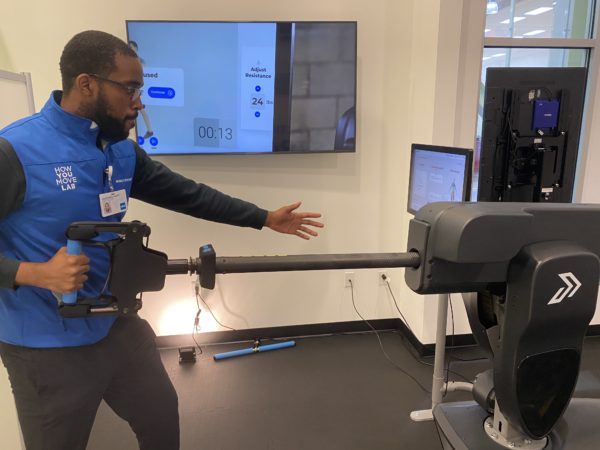HSS aims to improve motion health
The Hospital for Special Surgery (HSS) will soon be launching its consumer-facing motion health assessment and improvement initiative.
The How You Move Lab (HYML), powered by HSS, is set to open its pilot location at Chelsea Piers in Stamford on Aug. 1. The lab will appeal to those seeking to improve their motion health and enhance existing fitness plans and sports capabilities by learning proper form and correct movement, which also goes to preventing aches and pains, and which the lab will help in providing by first collecting data about a client.
HYML seeks to leverage years of data and findings HSS has accrued on motion health and offer it to the public in easy-to-understand assessments and action plans for improving motion health, tailored to a specific client. The process begins when an interested individual first signs up online for an orientation session and provides his or her weight and height. Upon visiting the lab at Chelsea Piers, clients”™ movements are then assessed by the team of experts and mobility specialists.

“We have mobility specialists here who will work with helping the individual to understand what this data means for them, so they walk away with an individualized and clear roadmap to getting them to where they want to be in terms of their motion health,” said Polly de Mille, exercise physiologist and registered nurse at HSS.
The team at the lab stratifies this information according to the HSS Performance Pyramid, a mobility chart split into three tiers with the “functional wellness” tier at the bottom (tier 1), the “performance readiness” tier in the middle (tier 2) and the “specific performance readiness” tier at the top (tier 3).
“What we have found, historically is that even the highest-level athletes, if they”™re getting repeatedly injured, it”™s often something at the foundational level that is impacting their tier 3 sports-specific movement,” said Jaime Edelstein, assistant vice president, HSS Rehabilitation and Performance.
The functional wellness tier is composed of five categories: strength, balance and posture, mobility and symmetry, body composition/nutrition and cardiovascular fitness. The performance readiness tier”™s categories are power, agility and acceleration/deceleration, and the specific performance readiness tier is composed only of the sports-specific skill category.
The initial orientation session is spent asking a client to perform certain exercises and movements that are appropriate for one”™s age and level of activity, in addition to inquiring about the client”™s fitness and health goals. This goes into stratifying and scoring a client”™s performance as outlined by the mobility pyramid.
“When we get a score, we can put them in the appropriate wellness levels,” said Max Castrogaleas, exercise physiologist and HYML coordinator, “so that the individual is not doing something that”™s either too hard or too easy, so we”™re actually meeting them where they”™re currently at with their fitness.”
The full sessions that follow is when clients interact with the lab”™s equipment. The technology allows the mobility specialists to further measure clients”™ performance by capturing and quantifying their power and mobility.
Clients are asked to perform motions on the Proteus machine by applying resistance using the machine”™s bar attachment and with the guidance of a mobility specialist, which results in “3D” measurements. They are also instructed to perform certain motions and exercises such as squats and vertical jumps within the boundaries of the DARI Motion platform, which has a camera system to capture motion and create a digital skeletal wireframe that is superimposed and synchronized to a client”™s body and viewable on the display in front.
The data collected from these systems are put into a motion wellness report, which is uploaded to a server and clients may later view this information on their desktop computers at the end of a session. The report includes movement assessments, which give a score, up to 100%, to six of the performance categories outlined by the mobility pyramid: strength, balance and posture, mobility and symmetry, power, agility and acceleration/deceleration.
Scores are derived from comparisons to other individuals whose performances have been measured, based on age and sex. Also included in the report are journal notes by the mobility specialists, as well as messages and videos that guide clients toward improvement, which can be helpful if clients have received a score in a certain performance category deemed to be an “area of opportunity.”
Armed with this information and backed by years of scientific research and the latest technologies, it is believed that clients from all walks of life may benefit from 30-minute sessions at HYML.
“This is a customized experience and the foundation and the backing for it is in data,” said Edelstein. “There are no (fitness) applications out there at this time, which can customize down to the detail of assessing an individual”™s mobility, health, taking that information and then providing them with customized feedback to help support areas of opportunity.”
And while the lab provides a unique experience to consumers, its team noted that it is not meant to be a replacement for any fitness programs or applications, but rather a way to guide individuals to approach fitness goals and perform exercises in an efficient manner, without injury or excessive strain.
“This is really to set you up for success in whatever it is that you”™re doing. You have the information you need to know where your areas of opportunity are,” Edelstein said.